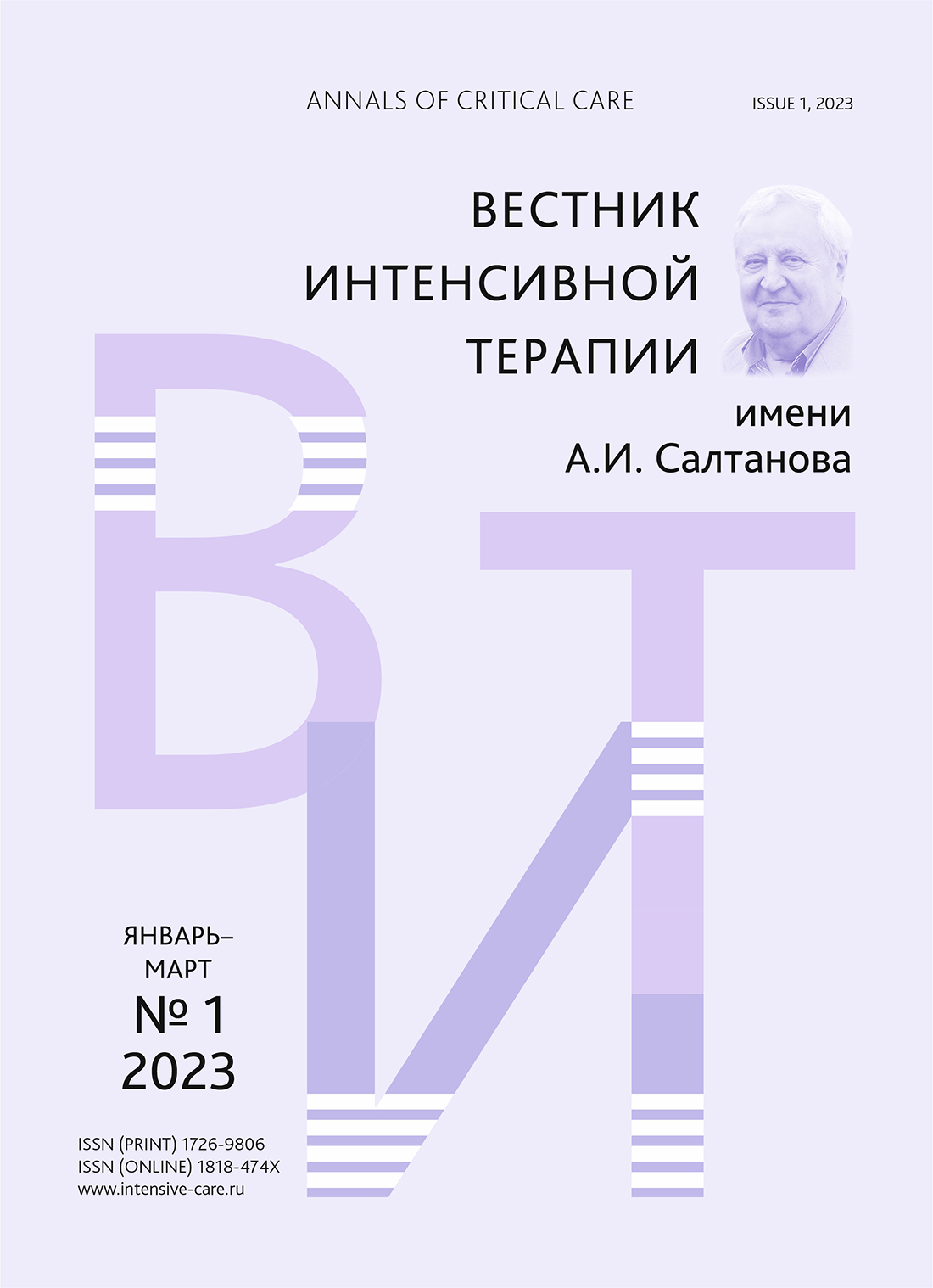Abstract
Intrahospital transportation of critical patients is a frequent procedure in the practice of most medical organizations, which in some cases is accompanied by a number of adverse events up to the occurrence of critical incidents. In order to improve patient safety, the Federation of Anesthesiologists and Reanimatologists of Russia (FAR) initiated in 2022 the development of national guidelines for the intrahospital transportation of critically ill adult patients. The literature search was focused on meta-analyses and randomized controlled trials, but also included registries, non-randomized comparative and descriptive studies, case series, cohort studies, systematic reviews, and expert opinion. Before publication, the guidelines were approved by the Presidium of the Board of the FAR. The guidelines are focused on the peculiarities of the organization of the process of intrahospital transportation, critical indicators of vital functions and their monitoring using methods for an objective assessment of the condition of patients. Special attention is paid to the need to form a specialized team and its training. For each recommendation, the level of evidence is presented. The guidelines were developed by experts in the field of anesthesiology and intensive care for anesthesiologists-reanimatologists and must be used as an evidence-based basis for making a decision to transport a particular critical patient by responsible health professional.
References
- Шустров В.В., Щеголев А.В., Заболотских И.Б. и др. Проведение межгоспитальной и внутригоспитальной транспортировки пациентов в критическом состоянии: результаты анкетного опроса. Вестник интенсивной терапии им. А.И. Салтанова. 2020; 4: 127–33. DOI: 10.21320/1818-474X-2020-4-127-133 [Shustrov V.V., Shchegolev A.V., Zabolotskikh I.B., et al. Inter-hospital and intra-hospital transfer of critically ill patients: results of a questionnaire survey. Annals of Critical Care. 2020; 4: 127–33. DOI: 10.21320/1818-474X-2020-4-127-133 (In Russ)]
- Братищев И.В., Каверина К.П., Яковлев В.Н. и др. Опыт и пути повышения безопасности транспортировки больных в тяжелом состоянии. Медицинский алфавит. 2010; 4(17): 36–8. [Bratishchev I.V., Kaverina K.P., Yakovlev V.N., et al. Opyt i puti povysheniya bezopasnosti transportirovki bol’nyh v tyazhelom sostoyanii. Medicinskij alfavit. 2010; 4(17): 36–8. (In Russ)]
- Горбачев В.И., Лохов А.В., Каретников И.А. Транспортировка пациентов с церебральной патологией в критическом состоянии. Анестезиология и реаниматология. 2017; 62(6): 457–62. DOI: 10.18821/0201-7563-2017-62-6-457-462 [Gorbachev V.I., Lokhov A.V., Karetnikov I.A. Transportation of patients with cerebral pathology in critical condition. Anesteziologiya I reanimatologiya (Russian Journal of Anaesthesiology and Reanimatology). 2017; 62(6): 457–62. DOI: 10.18821/0201-7563-2017-62-6-457-462 (In Russ)]
- Fanara B., Manzon C., Barbot O., et al. Recommendations for the intra-hospital transport of critically ill patients. Crit Care. 2010; 14(3): R87. DOI: 10.1186/cc9018
- Приказ Министерства здравоохранения РФ от 13 октября 2017 года № 804н «Об утверждении номенклатуры медицинских услуг» [Order of the Ministry of Health of the Russian Federation dated October 13, 2017 No 804n “On approval of the range of medical services”. (In Russ)]
- Касимов Р.Р., Махновский А.И., Миннуллин Р.И. и др. Медицинская эвакуация: организация и критерии транспортабельности пострадавших с тяжелой травмой. Политравма. 2018; 4: 14–21. [Kasimov R.R., Makhnovskiy A.I., Minnullin R.I., et al. Medical evacuation: organization and transportability criteria for patients with severe injury. Polytrauma. 2018; 4: 14–21. (In Russ)]
- Knight P.H., Maheshwari N., Hussain J., et al. Complications during intrahospital transport of critically ill patients: Focus on risk identification and prevention. Int J Crit Illn Inj Sci. 2015; 5(4): 256–64. DOI: 10.4103/2229-5151.170840
- Papson J.P., Russell K.L., Taylor D.M. Unexpected events during the intrahospital transport of critically ill patients. Acad Emerg Med. 2007; 14(6): 574–7. DOI: 10.1197/j.aem.2007.02.034
- Høyer C.B., Christensen E.F., Eika B. Standards of resuscitation during inter-hospital transportation: the effects of structured team briefing or guideline review—a randomised, controlled simulation study of two micro-interventions. Scand J Trauma Resusc Emerg Med. 2011; 19: 15. DOI: 10.1186/1757-7241-19-15
- Федеральный закон от 13 июня 1996 г. № 64-ФЗ «О введении в действие Уголовного кодекса Российской Федерации» [Federal Law No. 64-FZ of June 13, 1996 “On Enactment of the Criminal Code of the Russian Federation”. (In Russ)]
- Jones H.M., Zychowicz M.E., Champagne M., et al. Intrahospital Transport of the Critically Ill Adult: A Standardized Evaluation Plan. Dimens Crit Care Nurs. 2016; 35(3): 133–46. DOI: 10.1097/DCC.0000000000000176
- Intensive Care Society. Guidance on: the transfer of the critically ill adult. 2019: 1–40.
- Salt O., Akpınar M., Sayhan M.B., et al. Intrahospital critical patient transport from the emergency department. Arch Med Sci. 2018; 16(2): 337–44. DOI: 10.5114/aoms.2018.79598
- Damm C., Vandelet P., Petit J., et al. Complications during the intrahospital transport in critically ill patients. Ann Fr Anesth Reanim. 2005, 24: 24–30. DOI: 10.1016/j.annfar.2004.10.026
- Thim T., Krarup N.H., Grove E.L., et al. Initial assessment and treatment with the Airway, Breathing, Circulation, Disability, Exposure (ABCDE) approach. Int J Gen Med. 2012; 5: 117–21. DOI: 10.2147/IJGM.S28478
- Beckmann U., Gillies D.M., Berenholtz S.M., et al. Incidents relating to the intra-hospital transfer of critically ill patients. An analysis of the reports submitted to the Australian Incident Monitoring Study in Intensive Care. Intensive Care Med. 2004, 30: 1579–85. DOI: 10.1007/s00134-004-2177-9
- Ferdinande P. Recommendations for intra-hospital transport of the severely head injured patient. Working Group on Neurosurgical Intensive Care of the European Society of Intensive Care Medicine. Intensive Care Med. 1999; 25(12): 1441–3. DOI: 10.1007/s001340051096
- Brunsveld-Reinders A.H., Arbous M.S., Kuiper S.G., et al. A comprehensive method to develop a checklist to increase safety of intra-hospital transport of critically ill patients. Crit Care. 2015; 19(1): 214.
- Jarden R.J., Quirke S. Improving safety and documentation in intrahospital transport: development of an intrahospital transport tool for critically ill patients. Intensive Crit Care Nurs. 2010; 26(2): 101–7. DOI: 10.1016/j.iccn.2009.12.007
- Schwebel C., Clec'h C., Magne S., et al. Safety of intrahospital transport in ventilated critically ill patients: a multicenter cohort study*. Crit Care Med. 2013; 41(8): 1919–28. DOI: 10.1097/CCM.0b013e31828a3bbd
- Lin S.J., Tsan C.Y., Su M.Y., et al. Improving patient safety during intrahospital transportation of mechanically ventilated patients with critical illness. BMJ Open Qual. 2020; 9(2): e000698. DOI: 10.1136/bmjoq-2019-000698

This work is licensed under a Creative Commons Attribution-NonCommercial-ShareAlike 4.0 International License.

